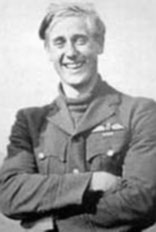Lewis, Albert Gerald
- Date of birth:
- April 10th, 1918 (Kimberley/Cape Of Good Hope, South Africa)
- Date of death:
- December 14th, 1982
- Nationality:
- South African
Biography
Service number 41303.
Albert Lewis was born 10th of April 1918 in Kimberly, South Africa.
He got interested in flying as a teenager and went through a private Flying School on his own account at the age of 18.
With his pilot license he went to Britain to join the Royal Air Force at the age of 20 – on a four year Short service Commission. After flying in different training units – and with different planes, he was posted to No. 616 South Yorkshire Squadron Auxiliary Air Force, which had been formed on 1st of November 1938 as a Bombing Squadron.
When he arrived, the Squadron flew Gauntlets, Tutors and Battles.
After some time he was transferred to an even duller job as a ferry pilot in No 12 Group Ferry Pool. Although the main business was ferrying aircrafts, they also found time to practise fighter tactics.
16th of December 1939 Lewis was transferred again. This time to No 504 Squadron, Debden. The Squadron flew Hurricanes, which was a great leap upwards for Lewis.
30th of January he flew the first of many single “Trawler Patrols”. This day marked his first meeting with the enemy, when he spotted and chased a German Blohm & Voss Seaplane.
At the outbreak of hostilities he then moved to No. 504 Squadron fighting in France. He then moved to No 85 Squadron still in France where he claimed 9 kills. More victories followed. Lewis baled out of his Hurricane badly burned on the 28th of September 1940 over Faversham.
He was not fit to flly until May 1941 when he joined 52 OTU as commander of 'C' Squadron.
In March 1942 he was posted out to the Far East, taking command of No. 261 Squadron in Ceylon.During the second Japanese attack on the island on 9 April, his unit took off in defence of China Bay, but he was delayed and followed them alone. As he climbed up, he was 'bounced' by Zeros and shot down, again being wounded. He returned to the UK in June 1942 and saw no further operational flying but was posted first as Chief Flying Instructor at Tealing, in Scotland, then at 10th Group HQ and at 11th Group HQ. He made a total of 18 victories and left the RAF in 1946.
After the war Lewis started farming. First in Britain - but in 1947 he went back home to South Africa.
In 1953-55 he studied agriculture in the USA , but in 1957 he returned to farm in England.
Promotions:
October 29th, 1938: Acting Pilot Officer
November 29th 1939: Pilot Officer
November 29th 1940: Flying Officer
November 29th, 1941: Flight Lieutenant
April 22nd, 1943: Acting Squadron leader
Do you have more information about this person? Inform us!
- Period:
- Second World War (1939-1945)
- Rank:
- Pilot Officer
- Awarded on:
- June 25th, 1940
"Pilot Officer Lewis has, by a combination of great personal courage, determination and skill in flying, shot down five enemy aircraft, single-handed, in one day. He has destroyed in all a total of seven enemy aircraft, and by his example has been an inspiration to his squadron."
- Period:
- Second World War (1939-1945)
- Rank:
- Pilot Officer
- Awarded on:
- October 22nd, 1940
"One day in September, 1940, this officer destroyed six enemy aircraft; this makes a total of eighteen destroyed by him. His courage and keenness are outstanding."
Awarded as a bar for on the ribbon of the first DFC.
Sources
- Photo 1: Aces Of WW2 Homepage
- Photo: Aces Of WW2 Homepage
- - SHORES, CH. & WILLIAMS, C., Aces High, Grub Street, London, 1994.
- The London Gazette Issue 34881 published on the 25 June 1940
- The London Gazette Issue 34976 published on the 22 October 1940
- LIFE magazine, issue 24 March,1941
- The South African Military History Society
- Aces of WWII
- thefedoralounge.com



